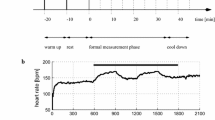Summary
In exercise training, precise control of exercise intensity would maximize the training efficacy while minimizing risks. To adjust work rate, heart rate (HR) has been used as a measure of exercise intensity. Thus, we developed a servo-controller of HR using a cycle ergometer. After estimating the transfer function from work rate to HR, we optimized feedback parameters for achieving a quick and stable HR response by means of a computer simulation. We then examined the performance of the servo-controller of HR in 55 healthy volunteers. We set the target HR at 60% and 75% of the age-predicted maximum HR. Times required for HR to reach 90% of the target HR were 136 ± 33 and 137 ± 22s in the respective protocols. Standard deviations of the steady-state difference between the target and measured HRs were 2.5 ± 0.6 and 3.8 ± 1.1 beats/min. We conclude that the developed servo-controller makes it possible to precisely regulate HR and, thereby, exercise intensity.
Similar content being viewed by others
References
Dracup K, Baker DW, Dunbar SB, Dacey RA, Brooks NH, Johnson JC, Carole O, Massie BM (1994) Management of heart failure: II. counseling, education, and lifestyle modifications. JAMA 272:1442–1446
O'Conner GT, Buring JE, Yusuf S, Goldhaber SZ, Olmstead EM, Paffenbarger RS, Hennekens CH (1989) An overview of randomized trials of rehabilitation with exercise after myocardial infarction. Circulation 80:234–244
Oldridge NB, Guyatt GH, Fischer ME, Rimm AA (1988) Cardiac rehabilitation after myocardial infarction. Combined experience of randomized clinical trials. JAMA 260:945–950
Giannuzzi P, Temporelli PL, Corra U, Gattone M, Giordano A, Tavazzi L (1997) Attenuation of unfavorable remodeling by exercise training in postinfarction patients with left ventricular dysfunction: results of the exercise in left ventricular dysfunction (ELVD) trial. Circulation 96:1790–1797
Philip AA, Waldmann ML, Meyer WL, Brown KA, Poehlman ET, Pendlebury WW, Leslie KO, Gray PR, Lew RR, LeWinter MM (1996) Skeletal muscle and cardiovascular adaptations to exercise conditioning in older coronary patients. Circulation 94:323–330
Philip AA, Waldmann ML, Poehlman ET, Gray P, Horton ED, Horton ES, Lewinter MM (1993) Autonomic function and exercise: exercise conditioning in older coronary patients: submaximal lactate response and endurance capacity. Circulation 88:572–577
Franklin GF, Powell JD, Workman ML (1990) Digital control of dynamic systems, 2nd edn. Addison-Wesley, New York, pp 158–230
Marmarelis PZ, Marmarelis VZ (1978) Analysis of physiological systems. Plenum, New York, pp 131–221
Takaki H, Sunagawa K, Sugimachi M, Hara Y, Kawada T, Kurita T, Goto Y (1998) Transient oxygen uptake response to exercise characterizes functional capacity of the cardiocirculatory system in patients with chronic heart failure: a random stimulus approach. Eur J Appl Physiol 78:333–339
Kawada T, Sunagawa G, Takaki H, Shishido T, Miyano H, Miyashita H, Sato T, Sugimachi M, Sunagawa K (1999) Development of a servo-controller of heart rate using a treadmill. Jpn Circ J 63:945–950
Brigham EO (1988) The first Fourier transform and its applications. Prentice-Hall, Englewood Cliffs, NJ, pp 167–203
Oppenheim AV, Schafer RW (1975) Digital signal processing. Prentice-Hall, Englewood Cliffs, NJ, pp 532–574
Author information
Authors and Affiliations
Additional information
This study was supported by Research Grants for Cardiovascular Diseases (6A-4, 7C-2, 7A-1, 9C-1) from the Ministry of Health and Welfare of Japan, by a grant from the Science and Technology Agency of Japan, Encourage System of COE, by a grant from the Ministry of Health and Welfare of Japan, Research on Advanced Medical Technology, and by a grant from the Fukuda Foundation for Medical Technology.
Rights and permissions
About this article
Cite this article
Kawada, T., Ikeda, Y., Takaki, H. et al. Development of a servo-controller of heart rate using a cycle ergometer. Heart Vessels 14, 177–184 (1999). https://doi.org/10.1007/BF02482304
Received:
Revised:
Accepted:
Issue Date:
DOI: https://doi.org/10.1007/BF02482304




